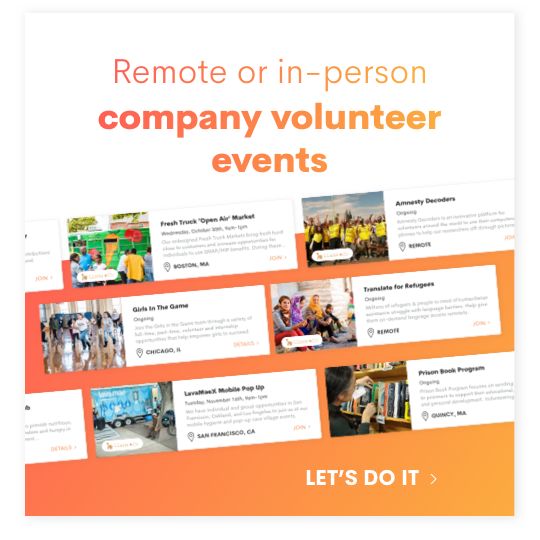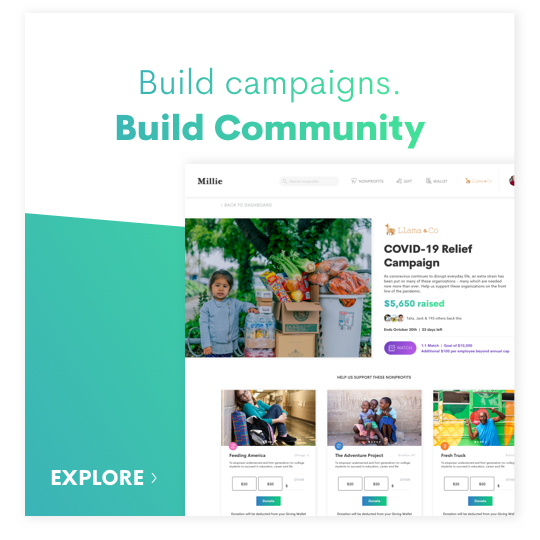Corporate social responsibility is in great demand by employees and consumers alike from the companies they work for and shop from. And the level of CSR expected from these businesses continues to grow. Today, studies indicate that nearly 2/3 of young employees won’t take a job at a company with poor CSR practices, while 77% of consumers purposefully purchase from companies committed to making the world a better place.
As a small business owner, you might worry that effective corporate social responsibility is out of your reach. But that couldn’t be farther from the truth! In fact, CSR is accessible—and beneficial—for businesses of all shapes, sizes, and sectors.
In this guide, we’ll walk through six key ways that small businesses can participate in corporate social responsibility. These include the following ideas:
- Launch a matching gift campaign.
- Offer dollars for doers.
- Host group volunteer events.
- Allow for VTO (volunteer time off).
- Provide charitable gift cards.
- Incentivize giving with gamification.
Ready to get started—and bring your company’s CSR strategy to new heights?
Let’s begin.
1. Launch a matching gift campaign.
Matching gifts are one of the most popular forms of corporate philanthropy, which is a key tenet of CSR. And lucky for you, starting a matching gift program can be easy! All it takes is to:
- Set a budget and establish matching criteria (minimums, maximums, ratios) accordingly.
- Determine to which nonprofits your company will match donations.
- Identify the match request process and a deadline for submissions.
- Inform team members about your new matching gift initiative.
- Start matching!
From there, you’ll have a functional program, which you can continue to tweak and improve as necessary. We recommend using an online submission portal to streamline the experience for you and your employees. For example, Millie partners with Double the Donation to enable innovative matching gift auto-submission!
2. Offer dollars for doers.
Dollars for doers—or volunteer grants, as they’re sometimes called—empower companies to provide monetary grants to the organizations their employees volunteer with. This is typically done by providing a set amount of funding per hour an employee volunteers with a qualifying nonprofit, though you may choose to contribute a lump sum upon an individual reaching a pre-determined hour threshold.
Like matching gifts, volunteer grants ensure that companies are supporting the organizations their employees have shown particular dedication to. So not only will such a program result in an improved public-facing brand image, but you’ll also see significant internal benefits as well. For example, employees will be increasingly engaged, you’ll see reduced staff turnover, and you’ll have unique opportunities to attract new talent.
3. Host group volunteer events.
Want to plan an activity for your company that benefits your local community and also provides an excellent team bonding experience? Organize a group volunteer event. See what nonprofits in your area are looking for volunteers, and get started!
A few ideas include:
- Serving in a soup kitchen
- Conducting a public cleanup
- Walking dogs at an animal shelter
- Sorting clothing for a local thrift store
- Assembling care packages
The possibilities are endless! Just make sure it’s something that your whole team (or at least a solid majority of the group) is eager to participate in. You can even collect ideas from team members to help gauge their interests.
4. Allow for VTO (volunteer time off).
More than likely, your employees already spend a portion of their free time volunteering with nonprofit organizations. Encourage them to do so with a notable incentive: additional paid time off to do so!
It’s a popular—and easy—option for companies looking to increase their social responsibility. In fact, one study by Double the Donation reports that over 65% of companies surveyed provide employees with paid-time volunteer programs.
This should be above and beyond any existing paid time off (i.e., vacation and/or sick time) and instead be dedicated to driving employee volunteerism.
5. Provide charitable gift cards.
Another easy way to boost CSR is by gifting funds that can be contributed to a wide range of nonprofit organizations. Your company can load specific amounts on charitable gift cards that you send to customers, prospects, and employees alike.
This unique opportunity drives social responsibility in a way that can engage all of your company’s stakeholders in tangible ways. Each of these groups will be glad to get involved with their favorite charities, and your company will be able to give back to the causes you know your audience supports.
For employees, you can gift each person a set amount of charitable dollars to contribute each year, or you may decide to use the idea to celebrate special occasions—such as birthdays or work anniversaries. As for customers and prospects, you can use the gift cards as a way to thank them for their time, support, and more.
6. Incentivize giving with gamification.
Nonprofits know that gamification is one of the best ways to drive engagement with fundraising efforts. The same ideas can be applied to your company’s CSR initiatives!
For example, a March Madness-esque bracket is a great way to rally company-wide support with a sense of friendly competition. Start with a list of employees’ favorite causes. Then have them “face-off” against one another bracket-style—team members voting with their dollars to advance their chosen groups—until you have a single organization to crown the winner.
By working with a third-party CSR management platform, facilitating corporate giving initiatives like these has never been easier—for you and your employees. Plus, Millie has partnered with Double the Donation, which works directly with the nation’s largest nonprofits, to streamline and simplify the end-user experience through tighter nonprofit integrations.
So what are you waiting for? Decide which program (or programs) you’d like to run, then begin crafting or finetuning your company’s overall philanthropic strategy. Your employees, customers, prospects, and other stakeholders will thank you.
Good luck!



